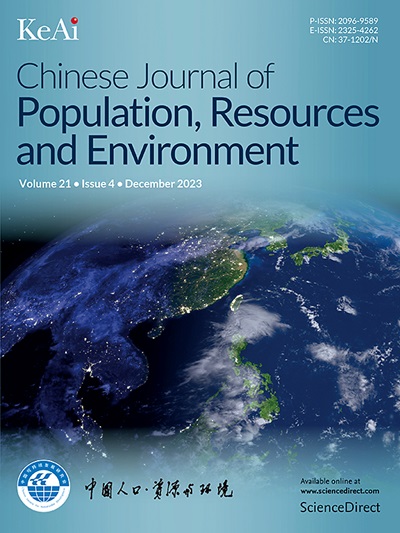Evaluating the technical and economic aspects of thermal performance of extensive green roofs: A GIS-based case study in the urban setting of Na- dor, Morocco
IF 4.8
4区 环境科学与生态学
Q2 ENVIRONMENTAL STUDIES
Chinese Journal of Population Resources and Environment
Pub Date : 2024-12-01
DOI:10.1016/j.cjpre.2024.11.005
引用次数: 0
Abstract
The increasing demand for green spaces in cities underscores the urgent need for sustainable solutions to reduce the ecological impact of urban areas. This research focuses on converting unused rooftops into extensive green roofs in Nador, Morocco, offering an innovative approach to enhancing outdoor thermal comfort in this region. Several advanced techniques were used, including photogrammetric restitution (for creating land use maps), integration of light detection and ranging data (for three-dimensional urban modeling), and meteorological data collection (for modeling urban climate conditions). The urban-multiscale-environmental-predictor solar and longwave environmental irradiance geometry (UMEP-SOLWEIG) model was crucial for precisely evaluating the thermal performance of green roofs and their influence on urban microclimates. This model considers considered various parameters, such as the sky view factor, wall height and aspect, and shading conditions, for accurate, comprehensive analysis. Additionally, for accurate, comprehensive analysis, a comparative evaluation was performed between the UMEP-SOLWEIG and ENVI-met models to assess the UMEP-SOLWEIG results. The findings were notable, demonstrating a substantial reduction (averaging over 3 °C) in the mean radiant temperature on 60% of rooftops, covering 55% of the total surface area. This highlighted the effectiveness of green roofs in improving outdoor thermal comfort. Furthermore, green roofs were closely associated with reductions in air-conditioning energy consumption, with considerable reductions ranging from 17.53% to 43.82%. These savings translated to estimated financial benefits ranging from USD 1.63–4.07 million. These figures clearly verified the notable economic impact of green roofs despite their initially high costs (approximately USD 84.44 million). These potential long-term savings indicated that these investments are financially viable in the long run. The collected data were used to create thermal maps of the area using geographic-information-system tools. A thermal cadaster specific to green roofs was also developed, accessible online through Web mapping. Overall, this approach facilitates decision-making in urban planning by providing visual information on thermal variations, thereby aiding in the precise planning of measures against urban heat and promoting the use of green roofs to reduce environmental impact.
评估广泛绿色屋顶热性能的技术和经济方面:摩洛哥纳多尔城市环境中基于gis的案例研究
城市对绿色空间的需求日益增长,迫切需要可持续的解决方案来减少城市地区的生态影响。本研究的重点是将摩洛哥纳多尔未使用的屋顶改造成大面积的绿色屋顶,为提高该地区的室外热舒适性提供了一种创新的方法。使用了几种先进技术,包括摄影测量恢复(用于创建土地利用地图)、光探测和测距数据集成(用于三维城市建模)和气象数据收集(用于模拟城市气候条件)。城市多尺度环境预测因子太阳和长波环境辐射几何(UMEP-SOLWEIG)模型对于准确评估绿色屋顶的热性能及其对城市小气候的影响至关重要。该模型考虑了各种参数,如天空景观因素、墙壁高度和朝向以及遮阳条件,以进行准确、全面的分析。此外,为了准确、全面的分析,在UMEP-SOLWEIG和ENVI-met模型之间进行了比较评估,以评估UMEP-SOLWEIG结果。研究结果非常显著,60%屋顶的平均辐射温度大幅降低(平均超过3°C),覆盖了55%的总表面积。这突出了绿色屋顶在改善室外热舒适方面的有效性。此外,绿色屋顶与空调能耗的减少密切相关,减少幅度从17.53%到43.82%不等。这些节省转化为估计的经济效益为163万至407万美元。这些数字清楚地证实了绿色屋顶的显著经济影响,尽管它们最初的成本很高(大约8444万美元)。这些潜在的长期节省表明,这些投资从长远来看在财务上是可行的。收集到的数据被用于使用地理信息系统工具创建该地区的热图。还开发了专门针对绿色屋顶的热地籍,可通过网络地图在线访问。总的来说,这种方法通过提供热变化的视觉信息来促进城市规划决策,从而有助于精确规划城市热量措施,并促进绿色屋顶的使用,以减少对环境的影响。
本文章由计算机程序翻译,如有差异,请以英文原文为准。
求助全文
约1分钟内获得全文
求助全文
来源期刊

Chinese Journal of Population Resources and Environment
ENVIRONMENTAL STUDIES-
CiteScore
4.30
自引率
1.10%
发文量
791
审稿时长
79 days
期刊介绍:
The Chinese Journal of Population, Resources and Environment (CJPRE) is a peer-reviewed international academic journal that publishes original research in the fields of economic, population, resource, and environment studies as they relate to sustainable development. The journal aims to address and evaluate theoretical frameworks, capability building initiatives, strategic goals, ethical values, empirical research, methodologies, and techniques in the field. CJPRE began publication in 1992 and is sponsored by the Chinese Society for Sustainable Development (CSSD), the Research Center for Sustainable Development of Shandong Province, the Administrative Center for China's Agenda 21 (ACCA21), and Shandong Normal University. The Chinese title of the journal was inscribed by the former Chinese leader, Mr. Deng Xiaoping. Initially focused on China's advances in sustainable development, CJPRE now also highlights global developments from both developed and developing countries.
 求助内容:
求助内容: 应助结果提醒方式:
应助结果提醒方式:


